If you set out to explain to a stranger to sailing everything that has been going on afloat and ashore at Volvo Cork Week 2018 (and we refer only to the official events), then you’d find yourself warbling away until Christmas and beyond writes W M Nixon.
Admittedly it may often seem like that in this comment section in any case. But in the matter of Cork Week in all its manifestations over the years, we carry a lot of baggage, having raced in the very early first mini-version which was staged in 1970 as part of the Royal Cork’s Quarter Millennial celebrations.
Following that, after 1974 when the RCYC opened the first stage of its new marina, the club could put on the welcome in a big way, and fresh possibilities were revealed with hosting ISORA Week 1976 at Crosshaven. Thanks in part to that, from 1978 onwards, the biennial RCYC Cork Week was born.
At its height in terms of numbers, the fleets were prodigious. But that was before the age of a cash-rich time-poor society, when doing anything for more than four days is seen as being too much of the long haul, with life today lived as a tasting menu of sports and recreations, changing almost from day to day and almost certainly from one weekend to the next.
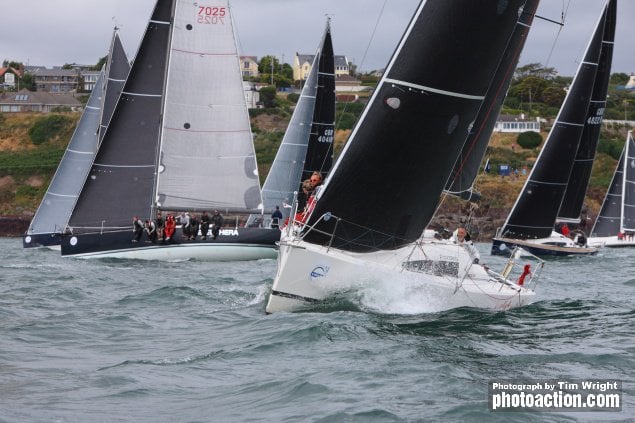 Classic Cork conditions – Class I race seawards
Classic Cork conditions – Class I race seawards
As well, for cruiser-racers, the “Ryanair effect” has surely played a role in reducing active numbers in Ireland. Back in the day when Cork Week was young, only an elite few kept their boats in the Med. It cost a lot to get there, and facilities were relatively sparse.
Yet now, if you get to a harbour in Croatia or Northwest Spain or Malta or wherever via one of the many cheap flights, you might well find more Irish cruiser-racers in active use than you do at home. There are also those who have copped on to the fact that the government-subsidised marinas in France (thanks to its heavily-taxed citizens) offer extremely good value. And like all those other places mentioned, the very fact of being on your boat in those distant places means you really are on holiday, whereas at home, even when on a boat it’s difficult to drop life’s everyday hassle.
Then, of course, the weather is another factor, with us now having to deal with the notion that too much “good” weather is actually very bad for Ireland and her economy. People managed to elude going into work in the recent heatwave, while our agricultural industry is much distressed. The fact is, the last thing we need is a Mediterranean climate, and if you want to sail in one, it’s much better that you have to go there to find it.
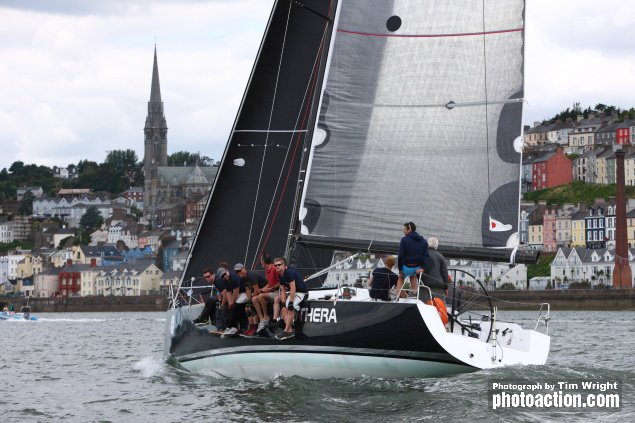 Frank Whelan’s Grand Soleil 44 from Greystones SC is an impressive looking machine, and she finished the Week in impressive style with the Class I win. Boat captain Paddy Barnwell told Afloat 'A combination of Olympic and windward leeward really suited the boat and crew on the last day. The crew pulled liked dogs and really smashed it!
Frank Whelan’s Grand Soleil 44 from Greystones SC is an impressive looking machine, and she finished the Week in impressive style with the Class I win. Boat captain Paddy Barnwell told Afloat 'A combination of Olympic and windward leeward really suited the boat and crew on the last day. The crew pulled liked dogs and really smashed it!
But in this time of rapid change, you have to makes some allowances for those of us who knew Cork Week when it was the liveliest sailing show in Europe. In the early 1990s, we’d a 35ft cruiser-racer which really did the business of being able to race and cruise, and when we went to Cork Week it was in the expectation of living on board, and somehow making the boat race-ready each morning.
We rather looked down our noses at those hyper-keen owners who rented a house in the village to accommodate their crew, and kept their boat in a stripped-out full-on racing conditions. Nevertheless, when I woke up one morning and found that there were eleven people sleeping aboard a boat which had only seven berths, there was a feeling that maybe things were going a bit too far. But we grabbed breakfast, piled superfluous gear onto the pontoon, and went out to race in heavy weather, getting fifth out of 25 in a reasonably competitive class.
Then it was ashore to hit the scene in the compound, the complete regatta village. We’d all sorts of passes to allow us to go everywhere within it, but when I had to go out the front gate on the Friday night, the security man asked me did I realize that everything indicated I hadn’t gone beyond the confines of the compound for the entire week. After due thought, it didn’t really surprise me at all.
But these days, we seem to have a Volvo Cork Week which, for the early part of the week at least, had two distinct focal points. The main scene is still in Crosshaven, but for one night – Tuesday – the glitzy bit was further up the harbour in the time-hallowed surroundings of the Naval Base in Haulbowline, where they held a Gala Dinner for all the Beaufort Cup competitors.
 Even when you’ve been racing round the Fastnet Rock the night before, the full dress uniform does wonders for the look of a man – Beaufort Cup winner Commandant Barry Byrne (left) and one of the visiting skippers at the Gala Dinner on Haulbowline Photo Bob Bateman
Even when you’ve been racing round the Fastnet Rock the night before, the full dress uniform does wonders for the look of a man – Beaufort Cup winner Commandant Barry Byrne (left) and one of the visiting skippers at the Gala Dinner on Haulbowline Photo Bob Bateman
As they’d been racing round the Fastnet the night before, maybe it was excusable that some of the civilian participants made a rather feeble effort at complying with the black tie requirement. But the naval, military and air force types cleaned up a treat with some very classy dress uniforms in evidence, stylishly reinforcing the evening’s purpose of celebrating camaraderie and the challenges of offshore racing in surroundings about as different as you can get from the spooky atmosphere which surrounds the Fastnet Rock as night comes on.
The next day, it was back to the racing with the pressure on for those afloat, but there was also an opportunity to see how our predictions from a week ago were holding up, and as the series progressed through its early days, the results were very encouraging for the soothsaying department.
But that said, you’d need to have been a stubborn contrarian to expect anything other than success for Rory Fekkes’ little all-black F’nGr8 from Carrickfergus in Class 4, which came to Cork laden with successes from the Scottish Series in May, the Howth Wave regatta in June, and the Bangor Town Regatta at the beginning of July.
 The little black wonder – Rory Fekkes Quarter Tonner F’nGr8 from Carrickergus SC was bought for just eight thousand snots, and transformed into a champion
The little black wonder – Rory Fekkes Quarter Tonner F’nGr8 from Carrickergus SC was bought for just eight thousand snots, and transformed into a champion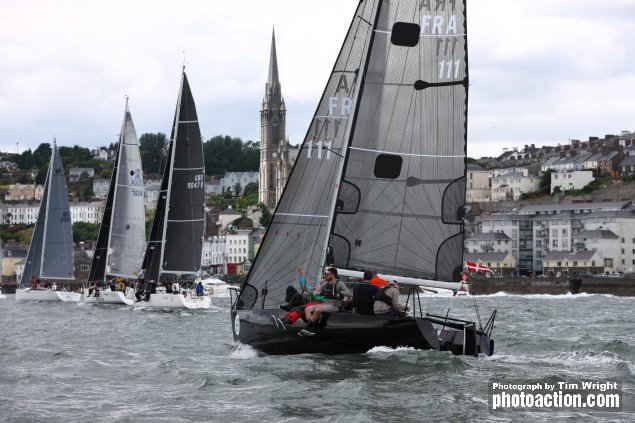 Rory Fekkes in the Harbour Race – the complete new suit of sails probably cost a good bit more than the bargain boat did in the first place
Rory Fekkes in the Harbour Race – the complete new suit of sails probably cost a good bit more than the bargain boat did in the first place
The boy has form, as tipsters would say – his father Paul was International GP14 World Champion in 1991, and Rory is no slouch himself on the dinghy circuit. But with this little keelboat which he bought in need of TLC for 8,000 sterling, he seems to have found the perfect outlet for Northern Irish technological ingenuity, and she has given a performance of almost chilling excellence in a class which is by no means lacking in boats of known high performance, discarding a sixth to finish first at 9.0pts, out of sight on James Matthews’ Kinsale-based Dubois Quarter Tonner Diamond on 26 points, with Paddy Kyne’s X-302 Maximus from Howth just one point behind in third.
From northern waters, we also mentioned Jonathan Anderson’s impressive J/122 El Grand Senor from Scotland as one to watch in Class 1, and she likewise has risen to the challenge. But a boat from within Strangford Lough which had to be content with third in class at Bangor, Jay Colville’s First 40 Forty Licks, was also tipped and she found new speed at Cork with the likes of Russell McGovern in her crew, and was right there at the top of the podium. However, in Friday’s final races, Frank Whelan’s very swift Grand Soleil 44 Eleuthera from Greystones seldom put a foot wrong to notch three wins to take the overall prize, with Forty Licks second and El Grand Senor third.
When the fleet is usually in several classes that seem to be going every which way, there’s something very reassuring about a big come-all-ye event which sends everyone across the same starting line at the same time to race round the same course, and Cork Week’s cherished Harbour Race on the Wednesday does that in style.
It could be a Race Officer’s nightmare, but PRO Jack Roy (El Presidente to his friends) was taking no nonsense. After one false start, the back flag rule was invoked, they were as good as gold, and in an intriguing event, a Howth boat took first overall, while another one was third.
 “El Presidente” – Cork Week PRO and Irish Sailing President Jack Roy in a previous existence when he sported a beard. Photo courtesy National YC
“El Presidente” – Cork Week PRO and Irish Sailing President Jack Roy in a previous existence when he sported a beard. Photo courtesy National YC
You may think I make a point of this because Howth is my home port. But on the contrary, it’s because it’s such an odd outcome. Howth is an artificial harbour on the end of a peninsula jutting out into the Irish Sea, and its race courses are set between two islands well clear of the coast. In other words, Howth boats race at home on courses about as different as humanly possible from the twists and turns and mud-hopping of Cork’s in-harbour course. Yet Jonny Swan from Howth with the pretty little classic Half Tonner Harmony came first in the Harbour Race, and while Rory Fekkes was second, Paddy Kyne from Howth with the X-302 was third ahead of Jay Colville in Forty Licks in fourth, the Simon Coveney crew in the J/109 Jedi in fifth, and Barry Byrne of the Defence Forces sixth in Joker II.
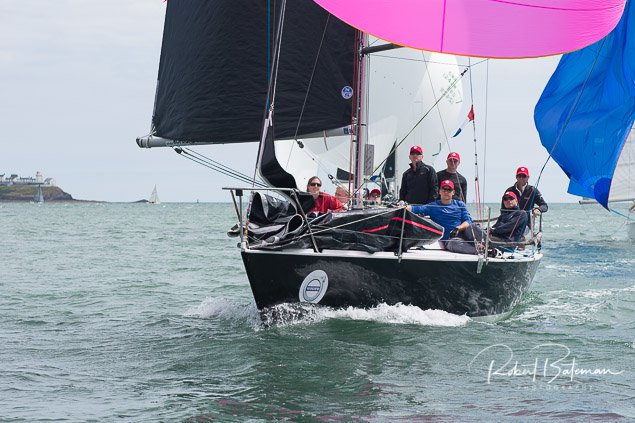 Jonny Swann’s Half Ton Classic Harmony, overall winner of the Harbour Race and second in Class 3
Jonny Swann’s Half Ton Classic Harmony, overall winner of the Harbour Race and second in Class 3
In other words, although Wednesday’s Harbour Race may be considered something of a fun event, those results are very much for real - these are serious contenders. And for Thursday and yesterday’s concluding races, it was back to set courses, Olympic stuff and all that, so how did it all pan out?
Well, for a while it looked as though Harmony would hang onto the overall lead in IRC 3 as well, but Jonny Swan was too eager on Friday morning and got the black flag, and in the afternoon he was fifth. But meanwhile the local Andrieu-designed Half Tonner Miss Whiplash (Ronan & John Downing) was in very smooth form, taking a first and second to move into a two point lead over Harmony in second, while Kieran Collins’ very interesting Olson 30 Coracle IV (a Californian speed design which originated in 1978, believe it or not) was third.
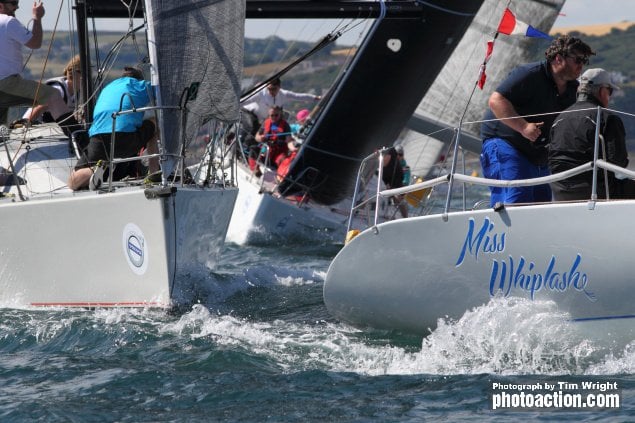 There she is – gone………Ronan & John Downing’s Half Tonner Miss Whiplash snatched the Class 3 lead with great sailing on the final day
There she is – gone………Ronan & John Downing’s Half Tonner Miss Whiplash snatched the Class 3 lead with great sailing on the final day
 One of the most interesting boats in the regatta, Kieran Collins’ 1978-designed Olson 30 Coracle IV was lying second in Class 3 until Miss Whiplash lived up to her name on the final day
One of the most interesting boats in the regatta, Kieran Collins’ 1978-designed Olson 30 Coracle IV was lying second in Class 3 until Miss Whiplash lived up to her name on the final day
So much attention was focused on the many J/109s in the Beaufort Cup series (with which we conclude this report) that it’s easy to overlook the fact that several others sister-ships were racing as standard entrants in Class 2, and this concluded with a battle for the class overall win between two of them, Ronan Harris’s Jigamaree from the Royal Irish YC in Dun Laoghaire, and the 2017 ISORA Champion Mojito (Vicky Cox & Peter Dunlop, Pwllheli SC). In the end, Mojito got it by a whisker, 14 pts to Jigamaree’s 15, which in turn was just one point ahead of sister ship Jelly Baby (Brian & Mary Jones, Royal Cork YC).
Come Thursday, and the One Designs came out to play - the 1720s and International Dragons - modern-looking boats you might well think, of a recent type. But in the case of the Dragon, you’d be much mistaken. Our main page for the night of Thursday July 19th and the morning of Friday July 20th had a sunny photo of the Dragons racing at Cork juxtaposed with the classic gaff ketch Maybird finishing the Round Ireland Race. Modern and ancient, you might well have thought. But the fact is the Dragon design by Johan Anker of Norway first appeared in 1929, while the design of Maybird by Fred Parker first appeared as Aideen in 1934, then was refined to become Maybird in 1937.
 One Design bliss - a pair of 1720s frame the International Dragons
One Design bliss - a pair of 1720s frame the International Dragons
But while Maybird has remained true to her roots, the only thing still original about the Dragon (which was first conceived as a small cruiser-racer) is the hull shape – everything else has been changed, and she still seems as modern as tomorrow. Certainly the class got a tremendous welcome back to Crosshaven, where they used to be very strong in the 1950s and 60s, and by yesterday evening’s conclusion, the overall winner was Daniel Murphy’s Serafina from Kinsale, with Peter Bowring’s Phantom (RIYC) second and Cameron Good’s Little Fella (KYC) third.
As for the 1720s, which originated in Crosshaven in 1994 and take their name from the RCYC’s foundation date as the Water Club of the Harbour of Cork, we mentioned in Tuesday’s Afloat.ie story, in reference to the classic 50ft sloop Northele recently bought by Anthony O’Leary, that for Volvo Cork Week, he’d be racing his 1720 Antix. He has indeed been doing that, and with a real flourish – four firsts and a second to put him out of sight on second-placed Dark Side (Brian Twomey) with the Welsh boat Luvly Jubbly third.
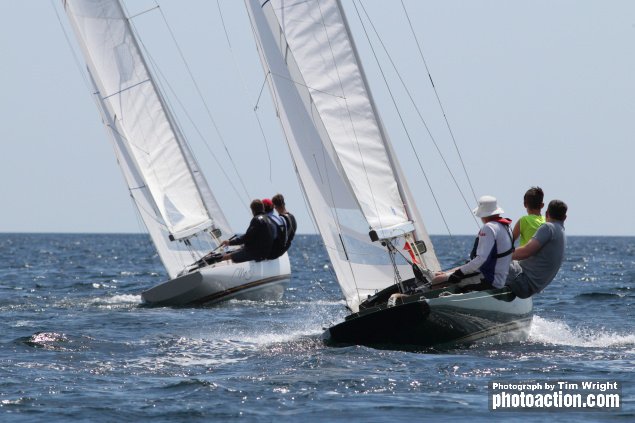 There’s something about the way an International Dragon sails to windward that speaks to all sailors
There’s something about the way an International Dragon sails to windward that speaks to all sailors
At a perhaps slightly more leisurely pace, a select group of ten boats chose to sail the entire regatta on daily coastal courses, though they also did the Harbour Race. Overall, they’d a historic winner – Denis Hewitt & partners of the RIYC on the Mills 36 Raptor, which was originally Aztec, built in 1996 by David Harte and Garrett Connolly for Peter Beamish. With a crew including Fintan Cairns, Nobby Reilly and Barry Rose, we can be quite sure that many issues had been fully discussed by this gathering of the Wise Men by the time Raptor concluded her successful series on a scoreline of 3,1,1,1, & 4.
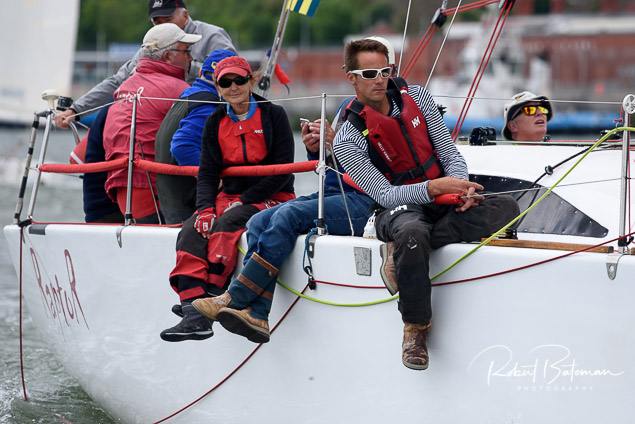 Denis Hewitt & partners of the RIYC on the Mills 36 Raptor
Denis Hewitt & partners of the RIYC on the Mills 36 Raptor
While all the One Design racing was getting into gear in the final two days, the Beaufort Cup was reaching its climax. This inter-services event now outshines everything else in Volvo Cork Week, and it has acquired such momentum it virtually has a life of its own. Although 2016’s inaugural staging was impressive, 2018’s has blown everything else away in its ability to capture popular imagination, and the way that the outcome went contested right to the end.
So what more can we say about Commandant Barry Byrne’s achievement in retaining the trophy? One of my favourite skippers always says that he would rather be lucky than good, and while I never discussed with him whether he meant good by moral or performance standards, every racing sailor knows exactly what he means.
Either way, in the Beaufort Cup, Barry Byrne and his Defence Force’s team sailing John Maybury’s J/109 Joker 2 carried off the Houdini act more than once, starting his campaign by coming from behind to win the Fastnet Race by four minutes and 11 seconds on the water, and then going on through the week to fight off challenges from Youen Jacob with the Baltimore RNLI in Andrew Alegeo’s J/109 Juggerknot, Tanaiste Simon Coveney and his Defence Forces crew on the Irish National Sailing School’s J/109 Jedi, and Dennis & Annamarie Murphy and the Crosshaven RNLI on their Grand Soleil 40 Nieulargo.
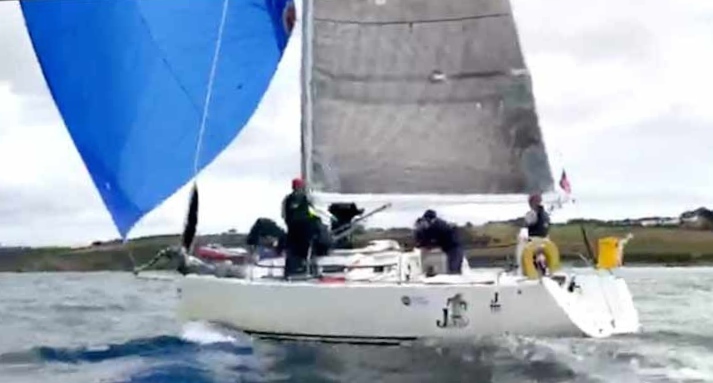 It may be only a blurry screen grab, but this was Joker 2 sweeping into Cork Harbour to win the Fastnet Race by four minutes and 11 seconds on the water, giving a mighty boost to Commandant Barry Byrne and his crew in their quest to retain the Beaufort Cup
It may be only a blurry screen grab, but this was Joker 2 sweeping into Cork Harbour to win the Fastnet Race by four minutes and 11 seconds on the water, giving a mighty boost to Commandant Barry Byrne and his crew in their quest to retain the Beaufort Cup
The pressure was kept up to the very end. With three race sailed yesterday (Friday), Youen Jacob gained a point with a first to Byrne’s second in the first race. But then Barry Byrne got back in the saddle with first in the second race while Jacob was fourth.
While the Byrne crew were ninth in the final race which was won by Tim Goodbody with Simon Coveney second, Youen Jacob was held back to sixth, and Commandant Barry Byrne and his crew had retained the Beaufort Cup only a fortnight after winning the Corinthian Division and taking second overall in the Volvo Round Ireland Race.
So there it goes, Volvo Cork Week 2018. Nail-biting finish to the Beaufort Cup with victory again for Barry Byrne, and a complete tour de force by Rory Fekkes and his little black boat from Carrick. Roll on 2020 and the Tricentenary.
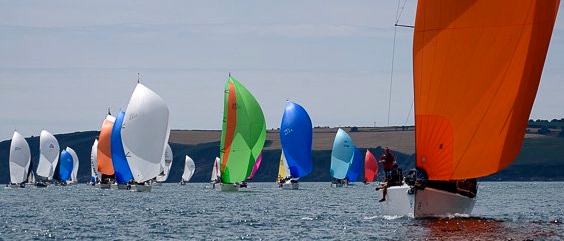 Summertime and sails on Cork Harbour, as it has been for three hundred years and more. Roll on 2020 and the Royal Cork Tricentenary……… Photo Robert Bateman
Summertime and sails on Cork Harbour, as it has been for three hundred years and more. Roll on 2020 and the Royal Cork Tricentenary……… Photo Robert Bateman
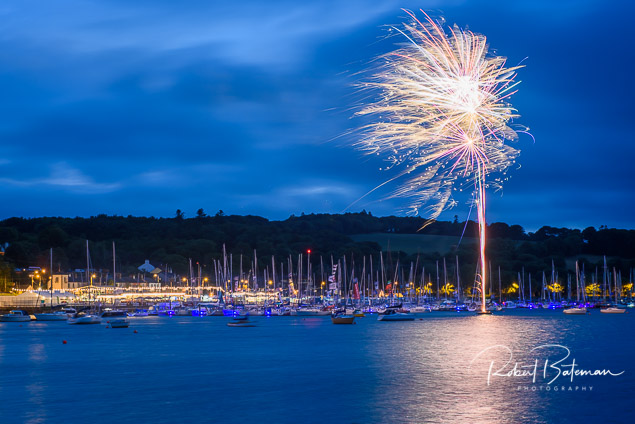 Fireworks mark the conclusion of 2018's Cork Week at Crosshaven Photo: Bob Bateman
Fireworks mark the conclusion of 2018's Cork Week at Crosshaven Photo: Bob Bateman
Click for Afloat.ie's Cork Week 2018 coverage in one handy link

































































